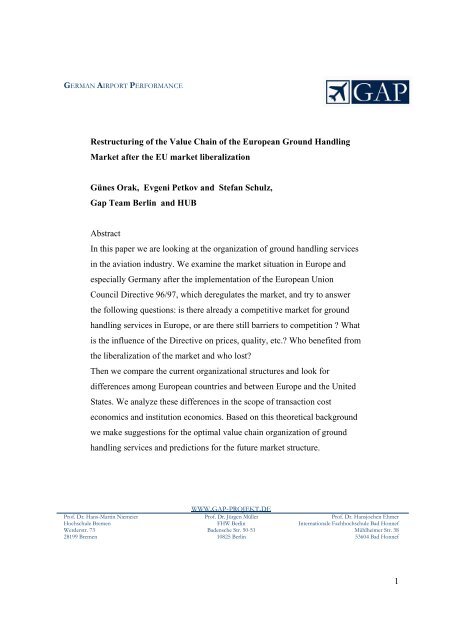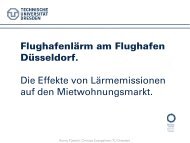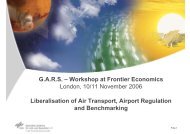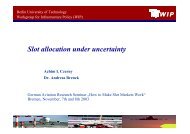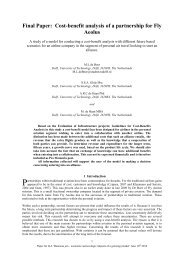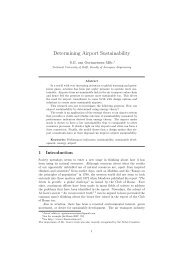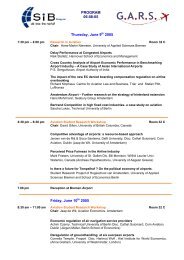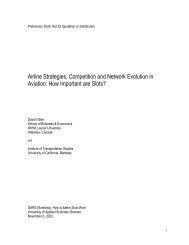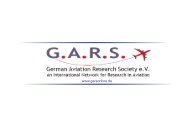1 Restructuring of the Value Chain of the European Ground ...
1 Restructuring of the Value Chain of the European Ground ...
1 Restructuring of the Value Chain of the European Ground ...
You also want an ePaper? Increase the reach of your titles
YUMPU automatically turns print PDFs into web optimized ePapers that Google loves.
GERMAN AIRPORT PERFORMANCE<br />
<strong>Restructuring</strong> <strong>of</strong> <strong>the</strong> <strong>Value</strong> <strong>Chain</strong> <strong>of</strong> <strong>the</strong> <strong>European</strong> <strong>Ground</strong> Handling<br />
Market after <strong>the</strong> EU market liberalization<br />
Günes Orak, Evgeni Petkov and Stefan Schulz,<br />
Gap Team Berlin and HUB<br />
Abstract<br />
In this paper we are looking at <strong>the</strong> organization <strong>of</strong> ground handling services<br />
in <strong>the</strong> aviation industry. We examine <strong>the</strong> market situation in Europe and<br />
especially Germany after <strong>the</strong> implementation <strong>of</strong> <strong>the</strong> <strong>European</strong> Union<br />
Council Directive 96/97, which deregulates <strong>the</strong> market, and try to answer<br />
<strong>the</strong> following questions: is <strong>the</strong>re already a competitive market for ground<br />
handling services in Europe, or are <strong>the</strong>re still barriers to competition ? What<br />
is <strong>the</strong> influence <strong>of</strong> <strong>the</strong> Directive on prices, quality, etc.? Who benefited from<br />
<strong>the</strong> liberalization <strong>of</strong> <strong>the</strong> market and who lost?<br />
Then we compare <strong>the</strong> current organizational structures and look for<br />
differences among <strong>European</strong> countries and between Europe and <strong>the</strong> United<br />
States. We analyze <strong>the</strong>se differences in <strong>the</strong> scope <strong>of</strong> transaction cost<br />
economics and institution economics. Based on this <strong>the</strong>oretical background<br />
we make suggestions for <strong>the</strong> optimal value chain organization <strong>of</strong> ground<br />
handling services and predictions for <strong>the</strong> future market structure.<br />
WWW.GAP-PROJEKT.DE<br />
Pr<strong>of</strong>. Dr. Hans-Martin Niemeier Pr<strong>of</strong>. Dr. Jürgen Müller Pr<strong>of</strong>. Dr. Hansjochen Ehmer<br />
Hochschule Bremen FHW Berlin Internationale Fachhochschule Bad Honnef<br />
Werderstr. 73 Badensche Str. 50-51 Mühlheimer Str. 38<br />
28199 Bremen 10825 Berlin 53604 Bad Honnef<br />
1
1. Introduction<br />
The <strong>Ground</strong> Handling Services(GHS) are an essential part <strong>of</strong> <strong>the</strong> final product <strong>of</strong>fered<br />
by an airline to <strong>the</strong> customer. GHS services are divided into 5 main categories (according to<br />
S&HE International Air Transport Consultancy (2003a)): ramp handling, baggage handling,<br />
fright/mail handling, fuel oil handling, passenger handling and o<strong>the</strong>r services. Below is <strong>the</strong><br />
graphical representation <strong>of</strong> <strong>the</strong> GH services.<br />
Figure 1. Overview <strong>of</strong> <strong>the</strong> <strong>Ground</strong> Handling Activities. (source: Fraport)<br />
These 5 activities could be done by <strong>the</strong> airlines <strong>the</strong>mselves (self-handling) or by a<br />
third party. The third party handlers can be airports, specialized ground handling companies,<br />
or ano<strong>the</strong>r airline, which serves as a third party handler. The global market for GHS was<br />
estimated to have a size <strong>of</strong> about 32bn € in … (Templin,2006).<br />
Therefore, how effective <strong>the</strong>se GH services are organized, and by whom <strong>the</strong>y are<br />
performed is a significant issue for all <strong>the</strong> stakeholders in GH industry: airlines, infrastructure<br />
suppliers (airports), independent GH service suppliers (handlers), customers, and <strong>the</strong><br />
2
governmental authorities, who regulate <strong>the</strong> GHS market. In this context, <strong>the</strong> aim is to look for<br />
<strong>the</strong> most efficient market organization.<br />
In <strong>the</strong> regulatory framework set by <strong>the</strong> governmental authorities, airlines, airports and<br />
handlers try to find <strong>the</strong> best governance structure for <strong>the</strong> vertical supply relationship among<br />
<strong>the</strong>m. Certainly, both concerns are contributed by academics, by <strong>the</strong> help <strong>of</strong> <strong>the</strong>oretical and<br />
empirical work.<br />
The vertical supply chain in ground handling starts with <strong>the</strong> airport continues with <strong>the</strong><br />
handler and ends with <strong>the</strong> airline. Two organizational problems are experienced along this<br />
supply chain. The first organizational problem arises because <strong>the</strong> handler should make a<br />
contract with <strong>the</strong> airport, to be able to use <strong>the</strong> facilities in <strong>the</strong> airport for handling tasks. One<br />
possible solution to this problem is forward integration <strong>of</strong> <strong>the</strong> airport. The second problem<br />
arises because <strong>the</strong> airline could also make a contract with <strong>the</strong> handler. Similarly, an additional<br />
solution can be backward integration <strong>of</strong> <strong>the</strong> airline.<br />
In this paper we are looking at <strong>the</strong> organization <strong>of</strong> ground handling services in <strong>the</strong><br />
aviation industry in Europe and especially Germany after <strong>the</strong> implementation <strong>of</strong> <strong>the</strong> <strong>European</strong><br />
Union Council Directive 96/97, which deregulates <strong>the</strong> market, and try to answer <strong>the</strong> following<br />
questions: is <strong>the</strong>re already a competitive market for ground handling services in Europe, or are<br />
<strong>the</strong>re still barriers to competition ? What is <strong>the</strong> influence <strong>of</strong> <strong>the</strong> Directive on prices, quality,<br />
etc.? Who benefited from <strong>the</strong> liberalization <strong>of</strong> <strong>the</strong> market and who lost?<br />
Then we compare <strong>the</strong> current organizational structures and look for differences among<br />
<strong>European</strong> countries and between Europe and <strong>the</strong> United States. We analyze <strong>the</strong>se differences<br />
in <strong>the</strong> scope <strong>of</strong> transaction cost economics and institution economics. Based on this <strong>the</strong>oretical<br />
background we make suggestions for <strong>the</strong> optimal value chain organization <strong>of</strong> ground handling<br />
services and predictions for <strong>the</strong> future market structure.<br />
3
2. The <strong>European</strong> Council Directive 96/67/EC<br />
Historically, in each country in Europe <strong>the</strong>re has been a national carrier, which<br />
dominated <strong>the</strong> market and worked closely with <strong>the</strong> airports. Because <strong>of</strong> this monopolistic<br />
situation, <strong>the</strong>re were little to no choice for GHS providers on <strong>the</strong> market. Moreover, airports<br />
had to approve <strong>the</strong> realization <strong>of</strong> GHS.<br />
However, after <strong>the</strong> liberalization <strong>of</strong> <strong>the</strong> airline industry, airlines were put under price<br />
pressure, which, in turn, forced <strong>the</strong>m to reduce costs, including GHS costs. Through lobbying<br />
<strong>the</strong>y exercised political pressure to liberalize also <strong>the</strong> GHS market, and hoped to get lower<br />
prices and better quality as result <strong>of</strong> competition. Opponents <strong>of</strong> <strong>the</strong> market opening were, as<br />
expected, <strong>the</strong> airports, which wanted to keep <strong>the</strong>ir monopoly and <strong>the</strong> trade unions, who feared<br />
more difficult and less lucrative working conditions for <strong>the</strong>ir members. Eventually, <strong>the</strong><br />
<strong>European</strong> Council implemented Directive 96/67/EC, which enforced competition on <strong>the</strong><br />
<strong>European</strong> GHS market, although allowing some exceptions. (see Flohr, 2007) . The main<br />
features are summarized below in Fig. 2.1 We will now look in detail at <strong>the</strong> developments at<br />
some <strong>of</strong> <strong>the</strong> major <strong>European</strong> airports below.<br />
Figure 2. Aspects <strong>of</strong> <strong>the</strong> Directive (see SH&E, 2002, p.10)<br />
4
3. The <strong>Ground</strong> Handling market at 6 major <strong>European</strong> hubs 1<br />
We now look at how <strong>the</strong> GHS market at Europe’s six largest airports looks like after<br />
<strong>the</strong> market opening. These are London Heathrow (LHR), Paris Charles de Gaulle (CDG),<br />
Frankfurt (FRA), Amsterdam Schiphol (AMS), Madrid Barajas (MAD) and Rome Fiumicino<br />
(FCO). All airports are <strong>the</strong>ir country’s largest, and serve as hubs to <strong>the</strong> respective national<br />
carrier (British Airways, Air France, Lufthansa, KLM, Iberia and Alitalia).<br />
We observe significant differences between <strong>the</strong> <strong>Ground</strong> Handling markets at <strong>the</strong>se<br />
airports with interesting variation in how <strong>the</strong> value chain is organized. Eight years after <strong>the</strong><br />
implementation <strong>of</strong> <strong>the</strong> EU Directive (we work with figures from 2004), only two <strong>of</strong> <strong>the</strong> six<br />
airports, London Heathrow and Amsterdam Schiphol, had a completely deregulated market<br />
with much self handling by airlines in evidence. 2 Toge<strong>the</strong>r with Madrid Barajas, <strong>the</strong> airport<br />
operators <strong>the</strong>re and at London Heathrow and Amsterdam Schiphol no longer <strong>of</strong>fer ground<br />
handling, whereas FRA, CDG and FCO still do. FRA is <strong>the</strong> only airport where <strong>the</strong>re is not a<br />
single self-handling airline present, not even Lufthansa. Therefore <strong>the</strong> proportion <strong>of</strong> third<br />
party handling is largest in FRA - 100%. It is lowest in MAD - 27%<br />
We observe significant variation in <strong>the</strong> value chain, with much selfhandling by airlines<br />
in evidence and also some airports strongly dominated by independent agents. In some<br />
countries <strong>the</strong> forward integration <strong>of</strong> <strong>the</strong> airport into GH service is however is still <strong>the</strong> norm.<br />
London Heathrow served a total <strong>of</strong> 67.3 m passenger in 2004, which makes it<br />
Europe’s largest airport. A total <strong>of</strong> eleven companies provide GHS <strong>the</strong>re, seven <strong>of</strong> <strong>the</strong>m being<br />
airlines, which do self and third party handling, and four <strong>of</strong> <strong>the</strong>m being specialized ground<br />
handling companies. These are Aviance UK, Plane Handling. Penauille Servisair, and<br />
Menzies.<br />
1 Much <strong>of</strong> this discussion is based on Templin, 2006.<br />
2 Only on <strong>the</strong>se two airports, some <strong>of</strong> <strong>the</strong> self-handling airlines do not <strong>of</strong>fer also third party handling<br />
5
Their market shares are as follows:<br />
26%<br />
3%<br />
3%<br />
4%<br />
3%<br />
6%<br />
4% 3% 3% 2%<br />
43%<br />
Figure 3. Market shares in LHR (see Templin, 2005b, p.14)<br />
British Airways<br />
Air Canada<br />
American Airlines<br />
United Airlines<br />
Air France Services<br />
Alitalia Servizi<br />
KLM <strong>Ground</strong> Services<br />
Aviance UK<br />
Plane Handling<br />
Penauille Servisair<br />
Menzies<br />
We see that <strong>the</strong> largest handler is British Airways, due mostly to its self-handling,<br />
while <strong>the</strong> largest independent third party handler is Aviance UK, holding 26% <strong>of</strong> <strong>the</strong> total<br />
market. However, airlines cannot really choose between all <strong>of</strong> <strong>the</strong> third party handlers, as<br />
none <strong>of</strong> <strong>the</strong>m operates on all four terminals, and some do it only on one terminal.<br />
LHR is also <strong>the</strong> most dynamic market <strong>of</strong> those discussed. Before <strong>the</strong> complete market<br />
opening, which occurred in 1999, eight airlines were providing self and third party handling.<br />
Right after that three independent handlers entered <strong>the</strong> market, and some airlines, which had<br />
previously been self-handling, decided to outsource <strong>the</strong>ir ground handling activities to one <strong>of</strong><br />
those companies. The market experienced fur<strong>the</strong>r changes in 2004, when Swissport, one <strong>of</strong><br />
<strong>the</strong> global handlers active on LHR decided to quit <strong>the</strong> market and was replaced by Menzies.<br />
Paris Charles de Gaulle handled 51.3 m passengers in 2004. The GHS market <strong>the</strong>re is<br />
partially opened, with three new independent handler competing with <strong>the</strong> incumbents<br />
Aeroports de Paris (ADP) and Air France. The independent handlers are Penauille Servisair,<br />
Groupe Europe Handling and Swissport. Air France is <strong>the</strong> only self-handler on CDG.<br />
6
The market structure is <strong>the</strong> following:<br />
6%<br />
13%<br />
14%<br />
2%<br />
Figure 4. Market structure on CDG (see Templin, 2005b, p.14)<br />
65%<br />
Air France<br />
However, as in Heathrow, not all five handlers operate on all three terminals, which<br />
reduces <strong>the</strong> choice <strong>of</strong> airlines to two or three providers, depending on <strong>the</strong> terminal.<br />
A specific feature <strong>of</strong> CDG is <strong>the</strong> use <strong>of</strong> subcontractors, who most <strong>of</strong> <strong>the</strong> time <strong>of</strong>fer services to<br />
all licensed ground handlers.<br />
Frankfurt hosted 51.1 m passengers in 2004, <strong>the</strong> third largest number in Europe. The<br />
special characteristic <strong>of</strong> Frankfurt is that, despite <strong>the</strong> large market size, not even <strong>the</strong> home<br />
carrier Lufthansa (having a market share <strong>of</strong> 63%) is self-handling. Airlines have a choice<br />
between Fraport, <strong>the</strong> former monopolist, and Acciona Airport Services, which entered <strong>the</strong><br />
market in 2000, after a tender process. In 2004, Acciona already had a market share <strong>of</strong> 20%,<br />
although growth at <strong>the</strong> beginning was slow, partly because <strong>the</strong>y were allowed to operate only<br />
on Terminal 2 until <strong>the</strong> end <strong>of</strong> 2000.<br />
The fourth largest <strong>European</strong> airport is Amsterdam Schiphol, with 42.5 m passengers in<br />
2004. There are four third party handlers present in Amsterdam: KLM, AviaPartner, Penauille<br />
Servisair and Menzies. Martinair has a license for third party handling, conducts, however,<br />
only self-handling.<br />
ADP<br />
Penauille Servisair<br />
Groupe Europe Handling<br />
Swissport<br />
7
The market is divided as follows:<br />
11%<br />
7%<br />
2%<br />
11%<br />
Figure5. Market structure in Amsterdam (see Templin, 2005b)<br />
It is interesting to note, that a third party handler which entered <strong>the</strong> market in 1999,<br />
exited in 2002, without being replaced.<br />
Madrid Barajas, with 38.7 m passengers in 2004, was one <strong>of</strong> <strong>the</strong> first airports where<br />
liberalization <strong>of</strong> <strong>the</strong> GHS market took place, as Spain started this process before <strong>the</strong> Directive<br />
was implemented. The company that received a permission to perform third party handling<br />
and become a competitor <strong>of</strong> <strong>the</strong> incumbent national carrier Iberia, was Ineuropa. There are<br />
also three airlines who do self-handling, but are not allow to <strong>of</strong>fer third party handling. As in<br />
London and Amsterdam, <strong>the</strong> airport operator is not involved in <strong>the</strong> GHS business. Therefore,<br />
out <strong>of</strong> <strong>the</strong> six analyzed airports, Madrid is <strong>the</strong> one with <strong>the</strong> highest percentage <strong>of</strong> self-handling<br />
– 73%. Out <strong>of</strong> <strong>the</strong> third party handling market, Iberia holds 60% and Ineuropa 40%.<br />
69%<br />
KLM<br />
Martinair<br />
AviaPartner<br />
Penauille Servisair<br />
Menzies<br />
8
12%<br />
7%<br />
1%<br />
11%<br />
Figure 6. Market structure on MAD (see Templin, 2005b, p.14)<br />
In Rome Fiumicino (28.1m passengers in 2004) <strong>the</strong> market is restricted to <strong>the</strong> airport<br />
operator (<strong>the</strong> former monopolist) and two airlines (Alitalia and Air One), which self-handle<br />
<strong>the</strong>ir flights, and provide also third party handling. There are no independent handlers and,<br />
although <strong>the</strong>re is a third self-handling license, no airline has requested its service. Therefore<br />
<strong>the</strong> market looks like that:<br />
33%<br />
17%<br />
69%<br />
Figure 7. Market structure on FCO (see Templin, 2005b, p.14)<br />
The market shares <strong>of</strong> Alitalia and EAS (Air One) are mostly due to self-handling while<br />
ADR (<strong>the</strong> airport operator) controls about 75% <strong>of</strong> <strong>the</strong> third party handling market.<br />
50%<br />
Iberia<br />
American Airlines<br />
Air Europa<br />
Spanair<br />
Ineuropa<br />
Alitalia Airport<br />
EAS<br />
ADR Handling<br />
9
4. Barriers to competition<br />
As shown above, on all airports <strong>the</strong>re is some competition, with <strong>the</strong> number <strong>of</strong><br />
competitors ranging from two (Frankfurt) to eleven (London). However, <strong>the</strong>re are still certain<br />
barriers to competition, even on <strong>the</strong> fully liberalized airports LHR and AMS.<br />
At Heathrow, as at all <strong>European</strong> airports, a handler has to go through an approval<br />
process, if it wants to operate on a terminal it is not currently serving. The approval has to be<br />
granted by <strong>the</strong> airport operator, and aims at limiting <strong>the</strong> number <strong>of</strong> handlers due to capacity<br />
constraints. On <strong>the</strong> o<strong>the</strong>r hand, <strong>the</strong> incumbent suppliers did not have to file for a licence, as<br />
<strong>the</strong> new entrants had to do.<br />
Capacity restrictions are also stated as <strong>the</strong> reason to keep potential new entrants out <strong>of</strong><br />
<strong>the</strong> market also in Frankfurt (only two third party handlers, no self handlers), Paris, Madrid<br />
and Rom. This issue is even more important at smaller airports, which we are currently<br />
investigating.<br />
This is, however, expected to change with a revision to <strong>the</strong> Directive, which is supposed to be<br />
implemented by 2008. It requires that at all airports with more than 20m passengers (all six<br />
analyzed airports fall into this category) <strong>the</strong>re should be at least four third party handlers<br />
permitted, as compared to two handlers currently. Fur<strong>the</strong>rmore, <strong>the</strong> definition for selfhandling<br />
is relaxed a bit, and handling an airline from <strong>the</strong> same alliance will also be<br />
considered as self-handling. The privileged situation <strong>of</strong> incumbents will also be changed and<br />
<strong>the</strong>y will also have to file for a ground handling license. (footnote one <strong>the</strong> status <strong>of</strong> <strong>the</strong> new<br />
directive)5. Effects <strong>of</strong> <strong>the</strong> liberalization on price and quality, winners and losers <strong>of</strong> <strong>the</strong> market<br />
opening.<br />
The purpose <strong>of</strong> <strong>the</strong> Directive was to achieve, through enforcing competition, lower<br />
prices and better quality <strong>of</strong> <strong>the</strong> ground handling services. To assess <strong>the</strong> effects <strong>of</strong> <strong>the</strong> policy, in<br />
2002 <strong>the</strong> <strong>European</strong> Council hired <strong>the</strong> consultancy SH&E, which conducted a survey on a large<br />
10
number <strong>of</strong> <strong>European</strong> airports. Here we summarize in brief <strong>the</strong> data on prices and quality (all<br />
data is from 2002).<br />
Of all airports presented in <strong>the</strong> study, a price increase was reported only from <strong>the</strong><br />
airport operators in Brussels and Manchester (prices on Manchester had fallen after <strong>the</strong><br />
market opening <strong>the</strong>re in 1992, and some independent handlers reported price decreases also<br />
after <strong>the</strong> implementation <strong>of</strong> <strong>the</strong> Directive). Some airports reported no price changes, and most<br />
reported price decreases, which were largest (up to 50%) in Lyon, Lisbon and A<strong>the</strong>ns.<br />
From <strong>the</strong> six largest airports, all reported a decrease in prices. Amsterdam, which had<br />
been a competitive market before <strong>the</strong> Directive came into force, reported decreases <strong>of</strong> only<br />
about 5 to 10 percent. In Frankfurt <strong>the</strong> airport authority reported a 5 to 15 percent decreases,<br />
whereas Acciona, <strong>the</strong> independent handler, reported just a decrease. Market participants in<br />
Madrid also reported just that <strong>the</strong>re was a decrease in prices, without providing figures. The<br />
effects <strong>of</strong> <strong>the</strong> Directive seems to be strongest in Paris and Rome, where decreases <strong>of</strong> 20 to 30<br />
percent where observed. An interesting case is London, where airport authorities declined to<br />
comment on prices, but some airlines reported 10 to 40 percent lower prices. Swissport, as an<br />
independent handler said that prices fell 25 to 30 percent and, as mentioned above, it exited<br />
<strong>the</strong> market in 2004.<br />
As expected, prices fell most in countries where <strong>the</strong> markets were completely closed<br />
before , whereas countries with already liberalized markets did not experience significant<br />
changes, as did those that opened only gradually, as seen in <strong>the</strong> case <strong>of</strong> Frankfurt. However,<br />
many market participants argued that prices fell mostly due to <strong>the</strong> development <strong>of</strong> increased<br />
competition in <strong>the</strong> airline industry and not due to <strong>the</strong> Directive.<br />
Considering quality, matters are not so easy to quantify. In general, quality decreases<br />
were reported from few airports, whereas most reported quality increase or no changes in<br />
quality.<br />
11
It is a quite ambiguous picture that emerges from <strong>the</strong> study and it is difficult to derive<br />
strong conclusions from it, but in general we can say that quality stayed more or less <strong>the</strong><br />
same. From <strong>the</strong> six hubs analysed, a decrease in quality is reported only from Amsterdam,<br />
with all o<strong>the</strong>r airports reporting no changes in quality. (see SH&E, 2002)<br />
From <strong>the</strong> above statement we may conclude that <strong>the</strong> Directive achieved, at least partly,<br />
its goals – prices decreased, while quality, in general, did not change. We want, however, to<br />
know also who captured those benefits, and if somebody lost from <strong>the</strong> market changes.<br />
It is clear that <strong>the</strong> airlines, which were <strong>the</strong> major driving force behind <strong>the</strong> market<br />
liberalization, and <strong>the</strong>ir customers gain from <strong>the</strong> lower prices. Unfortunately, <strong>the</strong>re are no<br />
indications that this gains are passed to <strong>the</strong> passengers. This is due to <strong>the</strong> fact that ground<br />
handling costs account to only 4 to 7 percent <strong>of</strong> total flight costs (see Smith, 2004, p.11).<br />
Therefore, even a decrease <strong>of</strong> ground handling prices <strong>of</strong> 50%, would decrease total flight<br />
costs by 2 to 4 percent.<br />
Improved quality, on <strong>the</strong> o<strong>the</strong>r hand, can easily be noticed by passengers, but, as stated<br />
above, we cannot conclude that service quality on <strong>European</strong> airports has improved as a result<br />
<strong>of</strong> <strong>the</strong> Directive.<br />
The independent handling companies are also among <strong>the</strong> gainers from <strong>the</strong> market<br />
opening, as now <strong>the</strong>y can grow by entering into new markets, <strong>the</strong>refore achieving fur<strong>the</strong>r<br />
economies <strong>of</strong> scale.<br />
The former monopolists have, expectedly, experienced significant losses <strong>of</strong> market<br />
share. For <strong>the</strong> airports we consider, <strong>the</strong>se ranged from 11% (Madrid) to 67 % (Rome).<br />
Considering <strong>the</strong> labor intensity <strong>of</strong> ground handling business, and that labor costs are<br />
about 80% <strong>of</strong> total costs in <strong>the</strong> industry (see Sterzenbach / Conrady 2003, p.164) we could<br />
expect that <strong>the</strong> price pressure has had a negative impact on employees, and this is <strong>the</strong> case.<br />
The respective countries have taken different measures to protect ground handling employees,<br />
12
however <strong>the</strong>y have affected only <strong>the</strong> incumbents‘ employees. A large part <strong>of</strong> <strong>the</strong> independent<br />
handlers‘ cost advantage is attributed to <strong>the</strong> fact that <strong>the</strong>y pay up to 30% lower wages, and<br />
have more flexible labor force (see Bender, 2005, p.8).<br />
6. Transformation <strong>of</strong> <strong>the</strong> <strong>Ground</strong> Handling Supply <strong>Chain</strong> and Theoretical Support<br />
Before <strong>the</strong> implementation <strong>of</strong> EU Directive, various structures were observed in<br />
Europe, as stated by Fuhr (2005). For example, passenger handling market was liberalized<br />
and competitive at most <strong>European</strong> airports, whereas in ramp handling market three different<br />
market structures could be observed. These were<br />
- monopoly <strong>of</strong> backward integrated national airline,<br />
- monopoly <strong>of</strong> forward integrated airport, and<br />
- duopoly or oligopoly <strong>of</strong> independent ground handlers and self-handling airlines.<br />
The EU Directive aimed at a liberalized governance structures in order to minimize <strong>the</strong><br />
operating costs and while maintaining or increasing <strong>the</strong> quality in GH services. However, due<br />
to conflicting interests <strong>of</strong> stakeholders, <strong>the</strong> implementation <strong>of</strong> EU Directive is still criticized,<br />
because <strong>the</strong>re are restrictions in third-party handling and self handling, award <strong>of</strong> handling<br />
licenses, minimum quality standards for handlers, etc. These issues are discussed at length in<br />
<strong>the</strong> document's underlying <strong>the</strong> recent revision <strong>of</strong> <strong>the</strong> Directive. (add footnote)<br />
As a contribution to this debate , Fuhr (2005) made propositions for a more efficient<br />
vertical supply chain organization, taking Transaction Cost Economics (TCE) as a basis for<br />
his studies. Examining <strong>the</strong> main hypo<strong>the</strong>sis <strong>of</strong> TCE, he developed an explanatory model<br />
specific to GH industry, and by <strong>the</strong> help <strong>of</strong> a qualitative case study in <strong>European</strong> Union, he<br />
tested <strong>the</strong>se propositions.<br />
In <strong>the</strong> following sections, first basics <strong>of</strong> TCE is discussed, hybrid governance<br />
structures are examined, <strong>the</strong>n Fuhr’s propositions and <strong>the</strong> conclusions he reached at <strong>the</strong> end <strong>of</strong><br />
his case study are given and discussed.<br />
13
As mentioned before, <strong>the</strong> market exchange along <strong>the</strong> supply chain may require<br />
contracts. Contracts are based on contractual law and define <strong>the</strong> conditions <strong>of</strong> exchange, in<br />
order to protect parties from opportunistic behavior, which is likely to be observed in <strong>the</strong> case<br />
<strong>of</strong> asset specificity and uncertainty after <strong>the</strong> contract is made. (Besanko, 2000; Ménard,<br />
2004). Transaction costs are “<strong>the</strong> costs <strong>of</strong> acquiring an input over and above <strong>the</strong> amount paid<br />
to <strong>the</strong> input supplier.” which include costs incurred before making <strong>the</strong> contracts (search and<br />
bargaining costs), opportunity cost <strong>of</strong> forgone transactions, costs incurred after making <strong>the</strong><br />
contracts (enforcing costs) as well as <strong>the</strong> opportunity cost <strong>of</strong> not choosing more pr<strong>of</strong>itable<br />
activities, if <strong>the</strong>re are any, by <strong>the</strong> end <strong>of</strong> or during <strong>the</strong> previous contract. (Ghosh and John,<br />
1999 ,Michael R. Baye, 2003,) As for TCE, developed by Williamson (1985, 991) it<br />
concerns determining <strong>the</strong> most efficient organization <strong>of</strong> exchange markets for intermediate<br />
goods and services. For this purpose, TCE examines governance structures from self handling<br />
and vertical integration to market coordination, hybrid organizations being in between, and<br />
having common properties with both extremes. Hybrid organizations are costly specialized<br />
governance structures, such as strategic alliances, joint ventures, and Japanese subcontracting<br />
networks, etc. (Besanko, 2000). They have three different forms: Weak (with short to midterm<br />
contracts), moderate (with long term contracts and reliable commitment) and strong form<br />
(e.g. Joint ventures or self-handling). As hybrid organizations get closer to strong form, <strong>the</strong><br />
duration and <strong>the</strong> complexity <strong>of</strong> <strong>the</strong> contracts; as well as <strong>the</strong> vertical control exerted by <strong>the</strong><br />
buyer on <strong>the</strong> supplier, increases.<br />
According to Williamson, <strong>the</strong> determinants <strong>of</strong> transaction costs are<br />
- <strong>the</strong> frequency <strong>of</strong> <strong>the</strong> contracts between two parties,<br />
- <strong>the</strong> specificity <strong>of</strong> investments made for <strong>the</strong> supply relationship,<br />
- -environmental or behavioral uncertainty,<br />
- -bounded rationality, and<br />
- -opportunistic behavior <strong>of</strong> individuals.<br />
Therefore <strong>the</strong>re are three main concerns <strong>of</strong> contactors, regarding <strong>the</strong> contracts along <strong>the</strong><br />
supply relationships. Ménard (2004).<br />
14
a) The first is <strong>the</strong> safeguarding against contractual hazards, which arises because <strong>of</strong><br />
specific investments and uncertainty. Contract terms on duration, quantity, and<br />
quality, adaptation clauses are examples <strong>of</strong> safeguards. Also reputation concern <strong>of</strong> <strong>the</strong><br />
parties and mutual trust are o<strong>the</strong>r possible safeguards.<br />
b) The second concern <strong>of</strong> <strong>the</strong> contactors is rent-distribution mechanism <strong>of</strong> <strong>the</strong> contract. If<br />
<strong>the</strong> contribution <strong>of</strong> <strong>the</strong> contactors to <strong>the</strong> supply relationship or <strong>the</strong> size <strong>of</strong> <strong>the</strong> resulting<br />
rent cannot be easily measured, or if measurement is costly, <strong>the</strong> distribution <strong>of</strong> rents is<br />
an issue between <strong>the</strong> contactors. (Barzel, 1989; Ghosh and John, 1999).Three<br />
possible rent-distribution mechanisms mentioned range from <strong>the</strong> least formal to <strong>the</strong><br />
most formal : reputation, negotiation devices (eg. Arbitrators for determining <strong>the</strong><br />
shares <strong>of</strong> rents), and a formal authority (an entity composed <strong>of</strong> delegates, to make he<br />
decision <strong>of</strong> rent-shares.)<br />
c) The third concern is <strong>the</strong> methods <strong>of</strong> enforcement. The enforcement entities from <strong>the</strong><br />
weakest to strongest are: trust, relational networks and formal governance.<br />
Based on this <strong>the</strong>oretical background, Fuhr developed an explanatory model for ramp<br />
handling activities in ground handling industry. In his study, firstly <strong>the</strong> airlines and airports in<br />
GH supply relationship are categorized as follows: The airlines are divided into two<br />
categories as Low Cost Carriers (LCCs) and Hub-and-Spoke Carriers (HSCs). LCCs have<br />
simplified routes, with point-to-point transit flights instead <strong>of</strong> transfers at hubs, and have<br />
supply relationships with handlers at two kinds <strong>of</strong> airports: base and non-base airports. HSCs<br />
have reduced number <strong>of</strong> routes between a number <strong>of</strong> spoke-airports and a central hub-airport,<br />
due to transfers at <strong>the</strong> hub, and have supply relationships with handlers at hub airports,<br />
secondary airports and spoke airports. Second, <strong>the</strong> determinants <strong>of</strong> transaction costs are used<br />
as a framework to assign values to <strong>the</strong> intensity <strong>of</strong> supply relationships handlers and <strong>the</strong> above<br />
mentioned five types <strong>of</strong> airports. Based on <strong>the</strong>se assignments, propositions about <strong>the</strong><br />
relationship between <strong>the</strong> transaction determinants and governance structuresns are tested for<br />
HSCs with <strong>the</strong> qualitative data collected through interviews with airline purchase managers<br />
and handlers about 69 different contracts between HSCs and handlers at hub, spoke and<br />
secondary airports in EU. These steps are analyzed for HSCs below:<br />
15
For <strong>the</strong> first determinant: frequency, it is suggested that HSCs’ transaction frequency<br />
with handlers is high at hub airports, medium at secondary airports and low at spoke airports,<br />
Since low frequency is not sufficient for implementing complex and costly governance<br />
structures, it is proposed that strong hybrid organizations and self handling is only feasible for<br />
HSC at <strong>the</strong>ir hub and secondary airports. To test this proposition, <strong>the</strong> number <strong>of</strong> handling<br />
events at hub, secondary and spoke airports and share <strong>of</strong> handling events done by handlers n<br />
total handling events are measured. As proposed, <strong>the</strong> handlers have <strong>the</strong> highest share (48%) in<br />
hub airports. However <strong>the</strong> case <strong>of</strong> secondary airports remained doubtful.<br />
For <strong>the</strong> second determinant: uncertainty, <strong>the</strong> environmental and behavioral uncertainty<br />
is considered separately. It is suggested that, environmental uncertainty between handler and<br />
<strong>the</strong> hub airport is moderate, whereas it is low between handler and secondary and spoke<br />
airports. This is interpreted as a sign <strong>of</strong> necessity <strong>of</strong> adaptation <strong>of</strong> contracts between two<br />
parties. Therefore is proposed that <strong>the</strong>re is low need for contract adaptation because<br />
environmental uncertainty is low. To test this, purchase managers are asked if renegotiation <strong>of</strong><br />
contracts were necessary due to external changes. 81% <strong>of</strong> <strong>the</strong>m said no. Therefore <strong>the</strong><br />
proposition s confirmed.<br />
On <strong>the</strong> o<strong>the</strong>r hand, behavioral uncertainty is high between handler and hub airport,<br />
whereas it is medium between handler and secondary airport and low between handler and<br />
spoke airport. This is interpreted as a sign for cost <strong>of</strong> performance assessing. Therefore it is<br />
proposed that safeguarding entities are needed in secondary and hub airports for performance<br />
assessment, if behavioral uncertainty increases; since <strong>the</strong>y are <strong>the</strong> airports where <strong>the</strong> human<br />
specificity is more crucial. To test this, <strong>the</strong> purchase managers are asked to evaluate <strong>the</strong><br />
resources spent on performance assessing in a scale 1 to 7. At hub airports 80% checked<br />
values more than 4, whereas at secondary airports only 50% and at spoke airports 27% did <strong>the</strong><br />
same.<br />
For <strong>the</strong> third determinant: Specificity; dedicated specificity, human specificity and<br />
contractual specificity are examined. Since ramp handling equipment is costly to move, and<br />
especially at hub airports it is specific to <strong>the</strong> fleet size and structure, a hold-up risk is observed<br />
16
at hub airports and high dedicated specificity is assigned to <strong>the</strong> relationship between handler<br />
and hub airports. Therefore it is proposed that <strong>the</strong>re is a large hold up threat in relationships<br />
between HSCs and handler, and a medium hold up threat in relationships between secondary<br />
airports and handler. To test this, <strong>the</strong> purchase managers are asked to evaluate <strong>the</strong> capability<br />
<strong>of</strong> a competitor <strong>of</strong> <strong>the</strong> current handler to provide necessary equipment in <strong>the</strong> short run. Mostly<br />
at spoke airports competitors manage this to a great extent, according to <strong>the</strong> purchase<br />
managers. However, at secondary airports competitors manage this to some extent, and at hub<br />
airports <strong>the</strong>y cannot manage it. This confirms <strong>the</strong> proposition that at hub airports <strong>the</strong>re exists<br />
high asset specificity, whereas at secondary airports it is medium. Also human capital<br />
specificity is a part <strong>of</strong> <strong>the</strong> hold-up problem. Therefore purchase managers are asked to decide<br />
to what extent <strong>the</strong> operational personnel is replaceable. It is observed that at spoke airports<br />
<strong>the</strong>y are replaceable to a great extent, at secondary airports to some extent and at hub airports<br />
<strong>the</strong>y are not replaceable at all. To test <strong>the</strong> dedicated specificity managers are asked <strong>the</strong> level <strong>of</strong><br />
<strong>the</strong> proportion <strong>of</strong> handling procedures, which are developed by handler specific to <strong>the</strong>ir<br />
airline. Similarly at hub airports 80% <strong>of</strong> <strong>the</strong> managers imply a high level <strong>of</strong> procedure<br />
specificity, whereas at secondary airports this portion is 45% and at spoke airports it is 30%.<br />
These three observations confirm <strong>the</strong> proposition that <strong>the</strong>re is high specificity <strong>the</strong>refore high<br />
hold up threat at hub airports whereas this threat is at a medium level at secondary airports.<br />
As <strong>the</strong> next step, <strong>the</strong> above mentioned three determinants <strong>of</strong> transactions are considered and<br />
propositions on <strong>the</strong> level <strong>of</strong> vertical control (i.e. <strong>the</strong> corresponding form <strong>of</strong> hybrid<br />
organization) are derived. It is proposed that weak hybrid modes should be observed between<br />
HSCs and handlers at spoke airports, moderate to strong forms should be observed between<br />
HSCs and handlers at secondary airports and strong forms should be observed at hub airports.<br />
In order to test <strong>the</strong>se propositions <strong>the</strong> level <strong>of</strong> vertical control should be measured. Since it is<br />
not an observable variable, <strong>the</strong> three concerns <strong>of</strong> contractors are examined, which are<br />
safeguards, rent distribution mechanisms and enforcement methods, since <strong>the</strong>se determine <strong>the</strong><br />
level <strong>of</strong> vertical control in a supply relationship.<br />
The measures <strong>of</strong> safeguards are chosen to be <strong>the</strong> contract duration and specification <strong>of</strong><br />
<strong>the</strong> quality service agreement, which is a standard procedure followed between <strong>the</strong> airline and<br />
17
<strong>the</strong> handler as a part <strong>of</strong> SGHA 3 . The contract duration at hub airports is on average 1919 days,<br />
whereas it is 940 days at secondary and 646 days at spoke airports. Similarly, at 67% <strong>of</strong> <strong>the</strong><br />
SLAs made between airlines and handlers at hub airports were highly specified, whereas this<br />
proportion is 65% at secondary and 7% at spoke airports. Moreover o<strong>the</strong>r forms <strong>of</strong><br />
safeguards, which are reputation, relational networks and trust, are also observed. It is seen<br />
that reputation and trust are more significant at spoke and secondary airports, whereas<br />
relational networks are less important.<br />
Complicated rent distribution mechanisms are not observed among <strong>the</strong> contracts,<br />
which are <strong>the</strong> sample for data collection. It is concluded that this may be due to low<br />
environmental uncertainty.<br />
As possible enforcement methods, arrangements such as <strong>the</strong> presence <strong>of</strong> a local<br />
manager or a quality manager at <strong>the</strong> airport, weekly or monthly operational and contractual<br />
meetings, and determination <strong>of</strong> malus payments, existence <strong>of</strong> a formal authority and o<strong>the</strong>r<br />
arrangements are observed. Moreover, <strong>the</strong> frequency <strong>of</strong> <strong>the</strong>se arrangements in supply<br />
relationships is calculated. All <strong>of</strong> <strong>the</strong>se arrangements are mostly observed in hub airports,<br />
medium in secondary airports and <strong>the</strong> least in spoke airports; indicating stricter enforcement<br />
methods at hub airports.<br />
All <strong>the</strong> findings on safeguards and enforcement methods confirm <strong>the</strong> propositions<br />
about <strong>the</strong> vertical control, whereas <strong>the</strong> rent distributing mechanism does not contribute to <strong>the</strong><br />
verification.<br />
Lastly, it is proposed that limited competition in ramp handling market would give rise<br />
to governance structures with higher vertical control, based on a <strong>the</strong>oretical analysis <strong>of</strong><br />
constraints and rights <strong>of</strong> agents in <strong>the</strong> ramp handling supply relationship. However this<br />
proposition could not find much support as expected. It is observed that especially at smaller<br />
airports ramp handling is done by publicly owned airports and it is inferred from <strong>the</strong><br />
3<br />
Standard <strong>Ground</strong> Handling Agreement is a contracting standard in GH industry established by International Air<br />
Transport Association.<br />
18
interviews that since public owners aim at maximizing regional welfare ra<strong>the</strong>r than<br />
maximizing pr<strong>of</strong>its, <strong>the</strong>y manage to avoid <strong>the</strong> opportunistic behavior by lower prices.<br />
When overall findings are observed among <strong>the</strong> several supply relationships between<br />
several airlines and <strong>the</strong>ir handlers at airports <strong>of</strong> different importance in EU, especially at hub<br />
and secondary airports <strong>the</strong> complexity and cost <strong>of</strong> transactions are relatively high; <strong>the</strong>refore<br />
high vertical control is observed. This is for <strong>the</strong> purpose <strong>of</strong> cost minimization and efficiency<br />
maximization. Therefore <strong>the</strong> handling-license award mechanism <strong>of</strong> EU Directive is strongly<br />
criticized in this paper. The EU Directive states that licenses must be awarded at most for 7<br />
years by <strong>the</strong> airport if independent ground handlers are present, or by <strong>the</strong> governmental<br />
authorities if <strong>the</strong> airport is forward integrated. However, since <strong>the</strong> required investments and<br />
<strong>the</strong> transaction costs are remarkably high in supply relationships, <strong>the</strong> airlines and independent<br />
handlers may not prefer to be involved in suggested specialized hybrid governance forms for<br />
only 7 years. This would result in less market entry and less competition in <strong>the</strong> GH market,<br />
which is not in accordance with <strong>the</strong> cost efficiency purposes <strong>of</strong> <strong>the</strong> EU Directive. In this<br />
context, <strong>the</strong> license conditions should be revised in order to encourage market entry.<br />
7. Conclusion:<br />
At <strong>the</strong> beginning <strong>of</strong> our paper we gave an overview over <strong>the</strong> ground handling industries and<br />
<strong>the</strong> EU Directive 96/67/EC, which was aimed at opening <strong>the</strong> market to competition, in order<br />
to achieve lower prices and better quality.<br />
The analysis <strong>of</strong> <strong>the</strong> ground handling market on <strong>the</strong> six largest <strong>European</strong> airports<br />
showed that <strong>the</strong> Directive had different success in <strong>the</strong> different countries, with some barriers<br />
to free competition still existing on all airports, due mostly to capacity constraints. Ano<strong>the</strong>r<br />
entry barrier is that third party handlers receive licenses for only up to seven years. Critics to<br />
<strong>the</strong> Directive point at <strong>the</strong> significant investments required and at <strong>the</strong> high transaction costs in<br />
<strong>the</strong> industry and state, that seven years is a too short period, and that this part <strong>of</strong> <strong>the</strong> Directive<br />
has to be revised in order to encourage more handlers to enter <strong>the</strong> market.<br />
19
However, new providers did enter <strong>the</strong> market, and prices did fall, not only on those six<br />
airports, but also on most <strong>European</strong> airports. It is difficult to derive such a general conclusion<br />
for <strong>the</strong> quality <strong>of</strong> <strong>the</strong> ground handling services, but we could say that on most airports it did<br />
not change. The winners <strong>of</strong> <strong>the</strong> market liberalization are <strong>the</strong> airlines and <strong>the</strong> new entrants to<br />
<strong>the</strong> market, <strong>the</strong> losers are <strong>the</strong> former monopolists and <strong>the</strong> employees.<br />
References:<br />
� Barzel, Y., 1989. Economic Analysis <strong>of</strong> Property Rights, Cambridge University Press:<br />
Cambridge, New York.<br />
Baye, Michael R. (2003) Managerial Economics and Business Strategy, 4th Ed, The<br />
McGraw-Hill Company,<br />
Bender, W., 2005. Mitarbeiter Dialog: Wir machen Fraport fit. Management Conference<br />
Fraport AG, 19.01.2005, unpublished<br />
� Flohr, L., 2007. Deregulierung von Bodenverkehrsdiensten an deutschen Flughäfen -<br />
Auswirkungen auf Personal und Organisation. Diplom-Arbeit at <strong>the</strong> Berlin School <strong>of</strong><br />
Economics.<br />
� Besanko D., Dranove D., Shanley M., 2000. Economics <strong>of</strong> Strategy<br />
� Fuhr J., 2005. Contracting Practices in <strong>the</strong> <strong>Ground</strong> Handling Market- A transaction Cost<br />
Explanation and Policy Implications<br />
� Ghosh M., John G., 1999. Governance <strong>Value</strong> Analysis and Marketing Strategy. Journal <strong>of</strong><br />
Marketing, Vol. 63, p. 131-145<br />
� Ménard, C., 2004. The Economics <strong>of</strong> Hybrid Organizations. Journal <strong>of</strong> Institutional and<br />
Theoretical Economics, Vol. 160, p. 345-376.<br />
� S&HE International Air Transport Consultancy, (2003a-b): Study on <strong>the</strong> Quality and<br />
efficiency <strong>of</strong> ground handling services at EU airports as a result <strong>of</strong> <strong>the</strong> implementation <strong>of</strong><br />
Council Diectiv9667/EC. Report to <strong>European</strong> Commission.<br />
� Smith, C., 2004. A <strong>Value</strong>d Business? – A Financial Overview, Presentation SH&E<br />
International Air Transport Consultancy, 6 th Annual <strong>Ground</strong> Handling International<br />
Conference, 30.11.2004, Budapest<br />
20
� Sterzenbach, R. / Conrady, R., 2003. Luftverkehr. Betriebswirtscahftliches Lehr- und<br />
Handbuch, 3., völlig überarbeitete und erweiterte Auflage, R. Oldenbourg Verlag, München<br />
2003<br />
� Templin, C., 2005b: Deregulation <strong>of</strong> <strong>Ground</strong> Handling on six <strong>European</strong> Airports,<br />
Presentation at GARS Workshop, June 2005,<br />
http://garsonline.de/Downloads/050609/Templin_slides.pdf (08.05.2006)<br />
� Templin, C., 2007. Competition on Airports – <strong>Ground</strong> Handling Services in Europe. Case<br />
studies on six major <strong>European</strong> Hubs. Forthcoming in: Peter Forsyth, David Gillen, Jürgen<br />
Müller, Hans-Martin Niemeier, David Starkie, Editors; Airport Competition; Ashgate, 2008<br />
� Williamson O.E., 1985. The Economic Institutions <strong>of</strong> Capitalism. The Free Press, New<br />
York<br />
� Williamson O.E., 1991. Comparative Economic Organization: The Analysis <strong>of</strong> Discrete<br />
Structural Alternatives. Administrative Science Quarterly, Vol. 36, 269-296<br />
21


